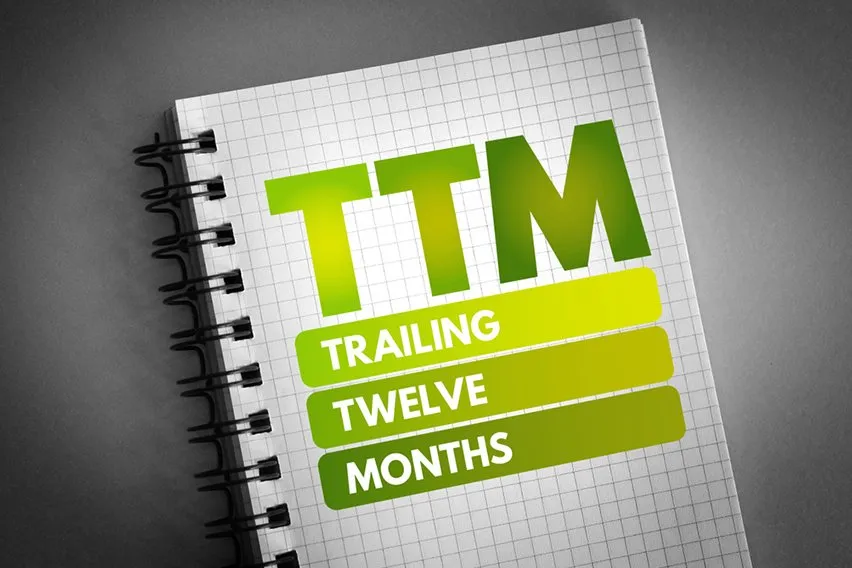What Is TTM (Trailing Twelve Months) in Finance?

As a small business owner, do you take care of all your accounting processes and financial data? Or do you have a dedicated accountant or bookkeeper? Regardless of your approach, there can be lots to know and understand.
Accurately completing and reporting your financial data is extremely important. Not only are you legally required to do so in several cases, but doing it properly can show insights into your business. You can see areas that might need adjustment or other areas for improvement.
In finance, you might have heard the term trailing twelve months, or TTM. But what exactly is it and what do you need to know? Let’s take a closer look.
Here’s What We’ll Cover:
What Is TTM?
TTM is a term that’s commonly used in finance to help describe your previous 12 consecutive months of performance data. You can use this data to help when it comes to reporting certain financial figures. That said, the 12 months that get looked at aren’t necessarily in line with your fiscal-year ending period.
Several investors and financial analysts will use TTM to generate a ton of financial data. This can range from everything from cash flows, balance sheet figures and income statements. However, it’s worth noting that calculating some TTM data might be different from one financial statement to the next.
For example, some analysts might need to report earnings on a quarterly basis, such as in the equity research space. Others might decide to do this on an annual basis. Investors, on the other hand, want to access daily information about things like stock prices and other data.

They might take a look at TTMs in a more relevant sense. This is since they want the most current financial data, which can get seasonally adjusted.
You can also use TTM figures to calculate financial ratios. For example, the price/earnings ratio can often get referred to as P/E (TTM). You would use this ratio to help calculate the current price of a stock and then divide that price by the trailing 12-month earnings per share (EPS).
One of the biggest parts of any type of financial analysis is comparing one thing against a similar thing from a prior term. This is done to help figure out how much growth was actually realized.
How Do You Find TTM?
In most cases, the TTM measure will get reported on your balance sheet. It’s usually done on a quarterly basis to help comply with the Generally Accepted Accounting Principles (GAAP). However, there are some analysts that decide to take the average of the first quarter and the last quarter, for example.
But what about line items on your cash flow statement, such as dividend payments, capital expenditures and working capital? These should be treated based on their feeding financial statement. For example, working capital is usually averaged and compiled of balance sheet line items.
It’s also important to recognize that depreciation gets deducted from income quarterly. This can mean that an analyst might only look at the last four quarters of an income statement.
TTM Revenue and TTM Yield
The revenue that you earn over the trailing 12 months of business gets described as TTM revenue. Using this data can be important if you want to determine if a company has experienced meaningful top-line growth. This is since the data is able to show exactly where that growth was generated from.

A TTM yield is going to refer to the total percentage of income that a portfolio has returned to its investors. This is based on the past 12 months. And it gets used to help analyze things such as an exchange-traded fund (ETF) or the performance of a mutual fund. You can calculate the TTM yield by finding the weighted average of all the yields.
And this is done with all the yields that are housed within a fund. It doesn’t matter if it’s a bond, a stock or another type of fund.
Key Takeaways
In finance, TTM is a common term to help describe your previous 12 months of performance data. This is important because it can significantly help when it comes to reporting your financial figures. TTM is commonly used by financial analysts and potential investors.
They use this data to get a better sense as to things such as income statements, balance sheet figures and cash flows. However, some TTM data could vary from one financial statement to the next. This is since some analysts decide to report earnings based on a quarterly basis.
Others could instead do this on an annual basis. Investors, however, want to access this data on a daily basis. This provides up-to-date information on certain things such as stock prices.
Did you enjoy reading this guide? Head over to our resource hub for more content!
RELATED ARTICLES

 Average Collection Period: Overview, Formula & Example
Average Collection Period: Overview, Formula & Example What Is Conservatism in Accounting: Definition & Principle
What Is Conservatism in Accounting: Definition & Principle How to Calculate CapEx (Capital Expenditure): Formula & Examples
How to Calculate CapEx (Capital Expenditure): Formula & Examples 66 Basic Accounting Terms You Need to Know
66 Basic Accounting Terms You Need to Know High-Low Method: Learn How to Estimate Fixed & Variable Costs
High-Low Method: Learn How to Estimate Fixed & Variable Costs Discounted Cash Flow (DCF): Formula, Examples & Calculation
Discounted Cash Flow (DCF): Formula, Examples & Calculation